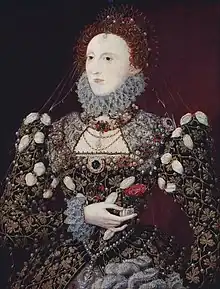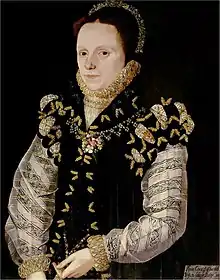
Walter Fyshe (died 1585) was a London tailor who worked for Elizabeth I until 1582.[1] He also made some of her farthingales.[2] Fyshe made the queen's ceremonial clothes and coronation robes, altering robes made for the coronation of Mary I of England.[3]
Career
Fyshe in mentioned in the royal accounts for 1557. He was a member of the Merchant Taylor's Company.Fyshe was sometimes asked to adjudicate disputed tailor's bills. He inspected the accounts of a tailor called Molde who had made clothes for Anne, the wife of Henry Mewtas (a son of Peter Meutas), in 1566. The case note mentions that Fyshe lived in Budge Row.[4]

Some garments made for Elizabeth involved the use of patterns called "toiles" which were sent to France for completion.[5] Some clothes were partly made in France and finished by Fyshe. Elizabeth was interested in the fashions of other European courts, and in 1567 the ambassador Henry Norris was asked to recruit a tailor in Paris who could make apparel in the Italian and French manner. Although Norris's wife Margery Williams, who Elizabeth nicknamed "Crow", agreed to help find a craftsman, no candidates were found.[6] The costume historian Janet Arnold suggests that the gown worn by Elizabeth in the 'Phoenix' portrait painted by Nicholas Hilliard may represent a pattern sent from France, possibly by Lady Norris, made up by Fyshe.[7][8]
After 1567, Elizabeth's farthingales were made a specialist, John Bate.[9] Fyshe made a cloak and safeguard for Bess of Hardwick to give to the queen, for New Year's Day 1577.[10]
In 1574 Fyshe was made a yeoman of the Revels.[11] Work for the Revels included costumes for musicians and actors dressed as Amazons for a masque at Richmond Palace in January 1579.[12] Amazons and knights arrived at the Palace, danced with the audience, and fought.[13] Fyshe bought coal to air the stored Revels costumes. He frequently signed the Revels accounts as "Walter Fysshe".[14]
Fyshe retired in 1582 and died in 1585. There are many records of his work at the English court. His will mentions a gift of a gold mourning ring to an embroiderer Davy Smith.[15] Fyshe married Elizabeth Worthington in 1547. She outlived him.[16]
Clothes for courtiers

Walter Fyshe and his workshop made clothes for Elizabeth's maidens of honour, ladies of the privy chamber and bedchamber, and chamberers. He made gowns of yellow satin with green velvet edging and silver lace for six maids of honour to attend the wedding of Anne Russell, daughter of the Earl of Bedford, to Ambrose, Earl of Warwick, on 11 November 1565. The maids were "Mistress Mary Howarde, Anne Windesoure, Katherine Bridges, Katherin Knevit, Mary Ratlyf and Dorothy Broke".[17]
Eleven gowns of crimson velvet, blue taffeta, and murrey satin, trimmed with sky blue "watchet" and white lace, were gifts from Elizabeth in 1572 to "Lady Susan Bowser, Mary Ratclyff, Eleaner Bridges, Elizabeth Garrett, Katheryn Howarde, Ysabell Holcrofte, Fraunces Howarde, Elizabeth Knolles, Anne Weste, Elizabeth Stafforde, and Mary Shelton".[18]
Some women received clothes when they married. In 1567, Dorothy Broadbelt, a gentlewoman of the chamber, was given a Flanders gown of black velvet with satin made by Fyshe when she married John Abington, a clerk of the royal kitchen.[19]
Fyshe and the Royal Wardrobes
George Brediman had responsibility for the Wardrobe of Robes. Several royal warrants directed to Brediman survive, referring both to the wardrobe at Whitehall or at Westminster. At this time, the same store was meant.[20] Brediman issued textiles for revels, to Katherine Astley for the queen's use, and to Walter Fyshe.[21]
References
- ↑ Janet Arnold, Queen Elizabeth's Wardrobe Unlock'd (Maney, 1988), pp. 65, 177.
- ↑ Ninya Mikhaila & Jane Malcolm-Davies, The Tudor Tailor: Reconstructing Sixteenth-Century Dress (Batsford, 2006), p. 21.
- ↑ Germaine Warkentin & John Carmi Parson, The Queen's Majesty's Passage & Related Documents (Toronto, 2004), p. 115.
- ↑ Cecil Monro, Acta Cancellariae: Or, Selections from the Records of the Court of Chancery, 2 (London, 1847), pp. 360-1, 363-4.
- ↑ Tracy Borman, The Private Lives of the Tudors: Uncovering the Secrets of Britain's Greatest Dynasty (Hodder & Stoughton, 2016): Ninya Mikhaila & Jane Malcolm-Davies, The Tudor Tailor: Reconstructing Sixteenth-Century Dress (Batsford, 2006), p. 42.
- ↑ Janet Arnold, Queen Elizabeth's Wardrobe Unlock'd (Maney, 1988), p. 115.
- ↑ Janet Arnold, Queen Elizabeth's Wardrobe Unlock'd (Maney, 1988), p. 116.
- ↑ Queen Elizabeth I, NPG 190
- ↑ Sarah Bendall, Shaping Feminity: Foundation Garments, the Body, and Women in Early Modern England (London, 2022), p. 118.
- ↑ Janet Arnold, Queen Elizabeth's Wardrobe Unlock'd (Maney, 1988), p. 178.
- ↑ Albert Feuillerat, Documents Relating to the Office of the Revels in the Time of Queen Elizabeth (Louvain, 1908), p. 73
- ↑ Jane Ashelford, Dress in the Age of Elizabeth I (Batsford, 1988), p. 127.
- ↑ Martin Wiggins & Catherine Richardson, British Drama 1533-1642, A Catalogue: II: 1567-1589 (Oxford, 2012), pp. 217-9 no. 657.
- ↑ Peter Cunningham, Extracts from the Accounts of the Revels at Court (London, 1842), pp. 101, 128, 133, 136.
- ↑ Janet Arnold, Queen Elizabeth's Wardrobe Unlock'd (Maney, 1988), pp. 178-80.
- ↑ Joseph Foster & Joseph Lemuel Chester, London Marriage Licences, 1521-1869 (London: Bernard Quaritch, 1887), 487.
- ↑ Janet Arnold, Queen Elizabeth's Wardrobe Unlock'd (Maney, 1988), p. 99-100.
- ↑ Janet Arnold, Queen Elizabeth's Wardrobe Unlock'd (Maney, 1988), p. 100.
- ↑ Janet Arnold, Queen Elizabeth's Wardrobe Unlock'd (Maney, 1988), p. 102.
- ↑ Janet Arnold, Queen Elizabeth's Wardrobe Unlock'd (Maney, 1988), pp. 141, 166, 171-2, 178.
- ↑ Craven Ord, 'Writs of Privy Seal', Archaeologia, vol. 16 (1812), pp. 91-94.